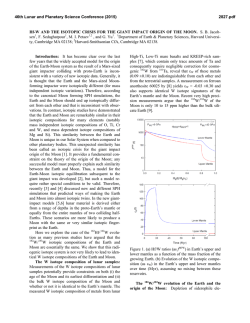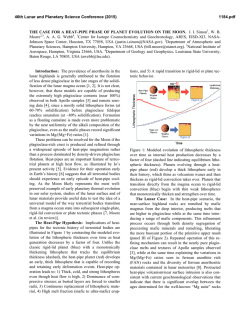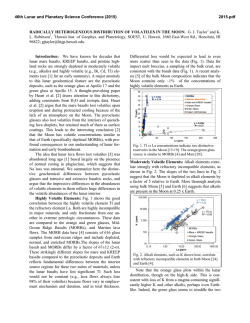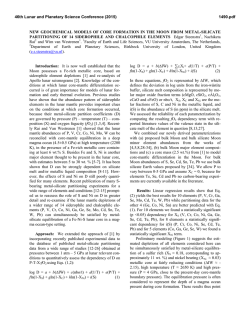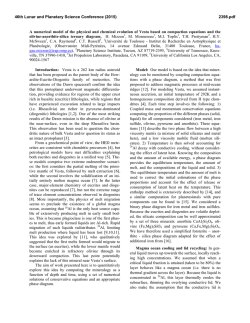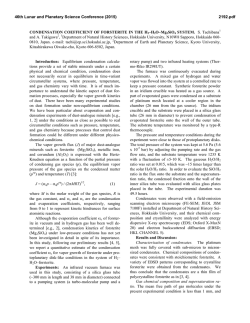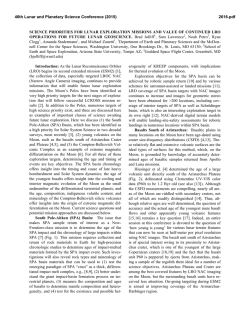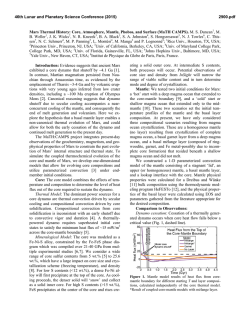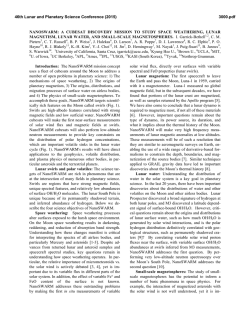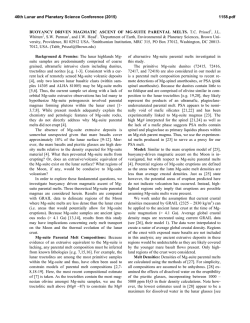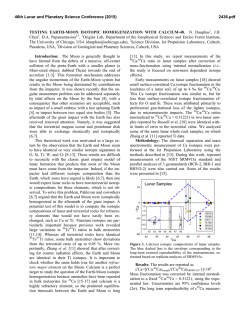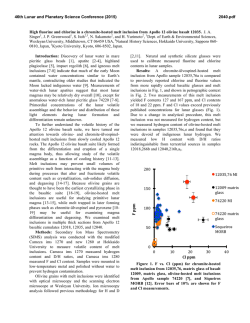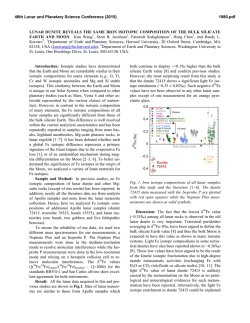
Low-Viscosity Zone of the Moon and Some Petrological Constrains
46th Lunar and Planetary Science Conference (2015) 1134.pdf LOW-VISCOSITY ZONE OF THE MOON AND SOME PETROLOGICAL CONSTRAINS ON ITS INTERIOR TEMPERATURE. S. A. Voropaev, GEOKHI RAS, Moscow, Kosygina str. 19, 119991 [email protected] Introduction: In recent paper Yuji Harada with collaborators showed that the attenuation of seismic waves in the deep lunar interior is expected to be consistent with a low-viscosity layer at the Moon core– mantle boundary with viscosity of about 2*1016 Pa s [1]. Numerically simulation was used for geodetic observations and frequency-dependent tidal dissipation that matches tidal dissipation measurements at both monthly and annual periods. Estimated viscosity of the lunar asthenosphere is much higher of about 1021 Pa s [2] which implies partial melting at the lunar core–mantle boundary in the layer with the outer (inner) radius of about 500 (320) km. It was also found that tidal dissipation is not evenly distributed in the lunar interior, but localized within the above lowviscosity layer. Analytical procedure: At GEOKHI RAS, group of Prof. Kuskov O.L. formulated the problem and described optimization method for solving the inverse problem – reconstructing the chemical composition of the zonal (stratified) mantle and the bulk composiotion of the silicate Moon [3]. The approach consists in the inversion of the available information on geophysical parameters (the velocities of the seismic waves, the moment of inertia and mass of the Moon) into the temperature and chemical composition. The main idea of this inversion is the minimization of the Gibbs free energy in the CaO-FeOMgO-Al2O3-SiO2 (CFMAS) system with phases of variable composition (nonideal solid solutions). The equations of state for the mantle material were calculated in the Mie-Grueneisen-Debye approximation by taking into account the phase transformation and anharmonicity effects. All calculations based on the THERMOSEISM software package and consistent thermodynamic database [4]. The most relevant result from the above consideration is the predicted composition of the mineralogical phases at a depth of 750 km (32 kbar, 1100 ºC) [5]. Olivine-Clinopyroxene-Garnet ( Ol-Cpx-Gar): 54,1% Ol (Fo89) + 36,8% Cpx (ClinoEn28Di44ClinoFs6,6Hed17Jd1,4ClinoCor3) + 0,6% Ilmenite (Geik60) + 8,5% Gar (Gros12Py70Alm18), (1) ρ ≈ 3,4 g/cm3. Reconstruction of the thermal state of the mantle of the Moon by the above approach causes the tempera- ture distribution at depths of H = 500-1000 km, which approximately can be described as T( H) 351 1718 1 e 0.00082 H 3 1.610 3 1.5510 T ( h) 3 1.510 3 1.4510 3 1.410 3 3 3 3 1.210 1.310 1.410 1.510 h Fig. 1 Temperature approximation at the lowviscosity zone (by the Kuskov approach). where for the upper boundary of the low-viscosity zone (RMoon = 1737 km): T(1237 km) = 1443 ºC (2) For adequate temperature distribution in the lower mantle, it is necessary that the velocity of seismic waves at depths of 500-1000 km to satisfy the following conditions: 8,0 ≤ Vp ≤ 8,2 km/s and 4,4 ≤ Vs ≤ 4,55 km/s (3) It coincides with the seismic data used in [1]. Olivine Clinopyroxene Garnet Fig. 2 Projection of liquidus surface of the system Mg2SiO4 (forsterite)-CaMgSi2O6 (diopside)Mg3Al2Si3O12 (pyrope) when P = 4 GPa [6]. 46th Lunar and Planetary Science Conference (2015) In the ternary system forsterite (Fo)-diopside (Di)pyrope (Py) at a pressure of 4 GPa (Fig. 2) melt crystallization begins with the extraction of forsterite at T = 1960 °C. When cooled, the number of forsterite increases, and the composition of the melt is displaced along the line XA, which passes through the top of the Fo. At point A begins joint crystallization of forsterite and pyrope, and the composition of the melt moves from A to E. At point E at T = 1670 °C crystallized eutectic mixture of forsterite, pyrope, diopside. Thus, the minerals precipitate from the melt in the sequence: Fo → Fo + Py → Fo + Py + Di. If the above rock consisting of forsterite, pyrope, diopside, begins to melt, and the melt remains in equilibrium with the crystals (model of batch melting), the first drop of liquid will have composition E. That is after diopside fully in the melt, the composition of the liquid phase will begin to shift from E to A. At point A will be fully expended pyrope, and with further heating, the composition of the melt changes along the line AX. At the point X will disappear forsterite, and the rock is molten at 100%. Results and discussion: The above discussed simple ternary system is basically similar to the composition of the mineralogical phases (1) at the low mantle depths. Its experimental petrological data allow us to estimate the range of temperatures of the low-viscosity layer from top to bottom as about 1670 °C - 1960 °C (4) We see a significant gap between the temperature evaluation (2) and (4). Thus, we confirmed the conclusion [1] that the tidal dissipation is not evenly distributed in the lunar interior, but localized within the low-viscosity layer. To answer the question why this is so, we have to refer to the shape of the Moon. The quantifying of the Moon’s topography is complicated by the large basins that have formed since the crust crystallized. Recently, Maria Zuber with collaborators estimated the large-scale lunar topography and gravity spherical harmonics outside these basins and show that the bulk of the spherical harmonic degree-2 topography is consistent with a crust-building process controlled by early tidal heating throughout the Moon [7]. The remainder of the degree-2 topography is consistent with a frozen tidal–rotational bulge that formed later, at a semi-major axis of about 32 Earth radii. Now, nonequilibrium shape and tidal interaction with the Earth causes a periodic deformation stress when the additional energy is released by the unloading. So, 1134.pdf the above-mentioned low-viscosity layer may serve as a thermal hub. Unfortunately, elegant spherical theory is hardly applicable to the Moon because of the above-mentioned strong anomaly. Exact analytical solution for the elastic deformations of the Moon’s mantle, taking into account the heterogeneity and non-equilibrium shape, could give a more accurate estimate of this heat source. The current approach for small bodies [8] need to develop for the Moon given the significance of the results for its thermal evolution. References: [1] Y. Harada et al. (2014) Nature Geoscience, 7, 569-572. [2] F. Nimmo et al. (2012) J. Geophys. Res., 117, E09005. [3] O.L. Kuskov (1997) Phys. Earth Planet. Inter, 102, 239-257. [4] O.L. Kuskov, V.A. Kronrod (2001) Icarus, 151, 204-227. [5] V.A. Kronrod, O.L. Kuskov (2011), Izv. Phys. Solid Earth, 47 (8), 711-730. [6] Yoder, H. S., Jr., Generation of Basaltic Magma, National Academy of Sciences, Washington, D.C., 1976. [7] M. Zuber et al. (2013) Science, 339, 668–671. [8] S. Voropaev (2013), 44th LPSC, Abstract #1135.
© Copyright 2025
